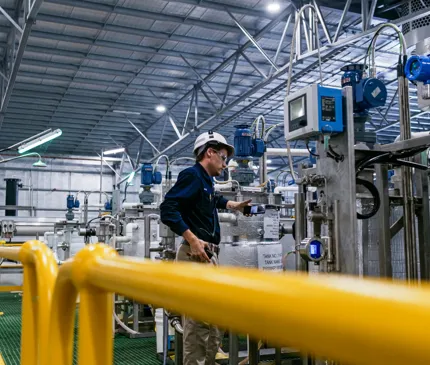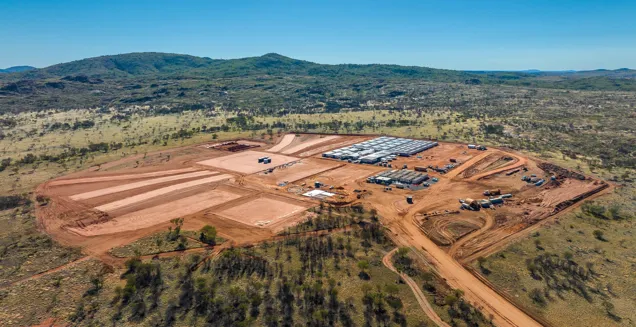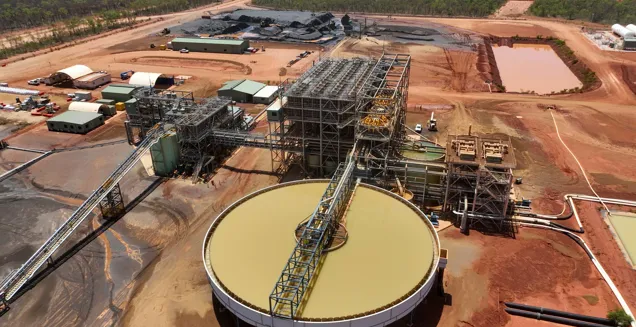HPA First Project
High-purity alumina facility in Gladstone supported by NAIF finance, supporting global demand for batteries and LED technologies.
January 2024
Resources
Gladstone, Queensland

The HPA First Project involves the development of a full-scale commercial plant and associated site infrastructure capable of producing over 10,000 tonnes per annum (tpa) of high purity alumina (HPA) and related high purity aluminium products.
About Alpha HPA
Alpha HPA Limited is a publicly listed, Australian-based company which has commercialised a proprietary technology to produce a growing range of HPA and related high purity aluminium products.
The company supplies advanced-technology sectors such as LED lighting, synthetic sapphire, semiconductors, direct lithium extraction, and lithium-ion batteries.
Project Overview
Based in the Gladstone State Development Area (GSDA), the 10-hectare, state-of-the-art facility will leverage the latest in process control systems and automation, capable of producing over 10,000 tpa HPA equivalent per year. The site intends to run on 100 per cent renewable energy.
Demand for HPA products has grown rapidly from a low base, and this trajectory is forecast to continue, prompted by use in high technology manufacturing sectors including LED lighting, lithium-ion batteries and in semiconductors. It is an ideal material for use in electronic screens, optical lenses, and protective coverings. These sectors and applications are all rapidly increasing in importance due to their role in the clean energy transition and decarbonisation of the global economy.
The Alpha HPA First project has a key strategic advantage through its proprietary processes and location. Using unique technology, the project will operate as a low-cost and low-carbon producer of high-purity alumina (HPA), outperforming traditional production methods currently used worldwide. Its integration and co-location in Gladstone alongside key partner and supplier Orica, as well as feedstock provider Rio Tinto, further strengthens its competitive position.
How We Helped
NAIF provided concessional finance with a longer loan tenor and flexible terms. Commercial lending appetite is low for many critical minerals projects, and for High Purity Alumina (HPA) there is almost no commercial appetite. Given the emerging and niche nature of the HPA sector, commercial lenders have very limited experience, and without NAIF and other government agency involvement to fill this funding gap, the project was unlikely to proceed.
Our role included de-risking the project by structuring finance to align with the development of long-life critical minerals infrastructure, encouraging private investment by providing early confidence to proceed, and ensuring the project could be delivered in line with broader government objectives.
The project is aligned with the Australian Government’s Critical Minerals Strategy, contributes to Australia’s clean energy transition, and creates opportunities and economic growth in regional communities. It also aligns with the Queensland Government’s policy to support regional economic development.
Public Benefit
The Alpha HPA project is set to inject $437 million into the regional economy over its construction and 20-year operational life and forecast to create 489 direct and indirect jobs during the construction phase and 204 ongoing operational jobs, driving local employment and economic activity.
High Purity Alumina (HPA) is crucial for technologies supporting the transition to sustainable energy sources, including lithium-ion batteries and LED lighting systems. Alpha HPA leads aluminium manufacturing innovation, supporting economic diversification and skilled jobs in Central Queensland.
Related links
Indigenous Engagement
- The First Nations Bailai, Gooreng Gooreng, Gurang and Taribelang Bunda peoples
Gladstone, located in Central Queensland, is within the traditional lands of the First Nations Bailai, Gooreng Gooreng, Gurang, and Taribelang Bunda (FNBGGGTB) People.
The Traditional Owners are represented by the Port Curtis Coral Coast Trust (PCCC), who provides administrative and operational support for the Registered Native Title Body Corporate (RNTBC or PBC).
The PBC is responsible for and manages all Native Title, Cultural Heritage, TUMRA, Land and Sea Claim interests across the region. The PCCC office delivers dedicated social programs and coordinates the cultural heritage protection programs.
The region is home to ecologically and culturally significant ecosystems, including mangroves, seagrass meadows, coral reefs, tidal wetlands, and coastal river systems, as well as eucalyptus woodlands and freshwater catchments inland.
Indigenous Engagement Strategy Commitments
- Committed to inviting FNBGGGTB People to participate in Company events and activities that foster engagement and inclusion.
- Working collaboratively with the PBC to explore opportunities for equity participation in the project.
- Supporting community connection through sponsorship of FNBGGGTB-led events.
- Enhancing employment and training outcomes for FNBGGGTB People through scholarships into both technical and non-technical roles across the project.
- Embedding recognition of participation of FNBGGGTB People into tender processes, with selection criteria that consider direct employment and business contracting opportunities.
Indigenous Engagement Strategy Commitments
Alpha HPA is scheduled to commence reporting on their Indigenous Engagement Strategy commitments to NAIF following Financial Close, in line with NAIF’s framework. However, Alpha has shared outcomes achieved to date including:
- Prior to and during early works, Alpha HPA engaged the PCCC to conduct cultural heritage surveys on the project’s site. Alpha HPA also invited the PBC to participate in an equity acquisition arrangement for the project.
- In 2022 and 2023, Alpha HPA funded sponsorships for the 1770 Cultural Immersion Festival, supporting community-led cultural celebrations.
- In 2024, Alpha HPA invited the PCCC to conduct a smoking ceremony at the Project’s construction commencement launch event. In the same year, Alpha HPA sponsored and attended the First Nations Chamber of Commerce and Industry Summit in Gladstone.
- To date, the project has achieved a 5 per cent Indigenous employment rate. To further build on this, Alpha HPA have initiated the development of tender selection criteria to recognise Tenderers who can demonstrate engagement of First Nations people or First Nations owned businesses with a preferential weighting for FNBGGGTB People where commercially viable.


